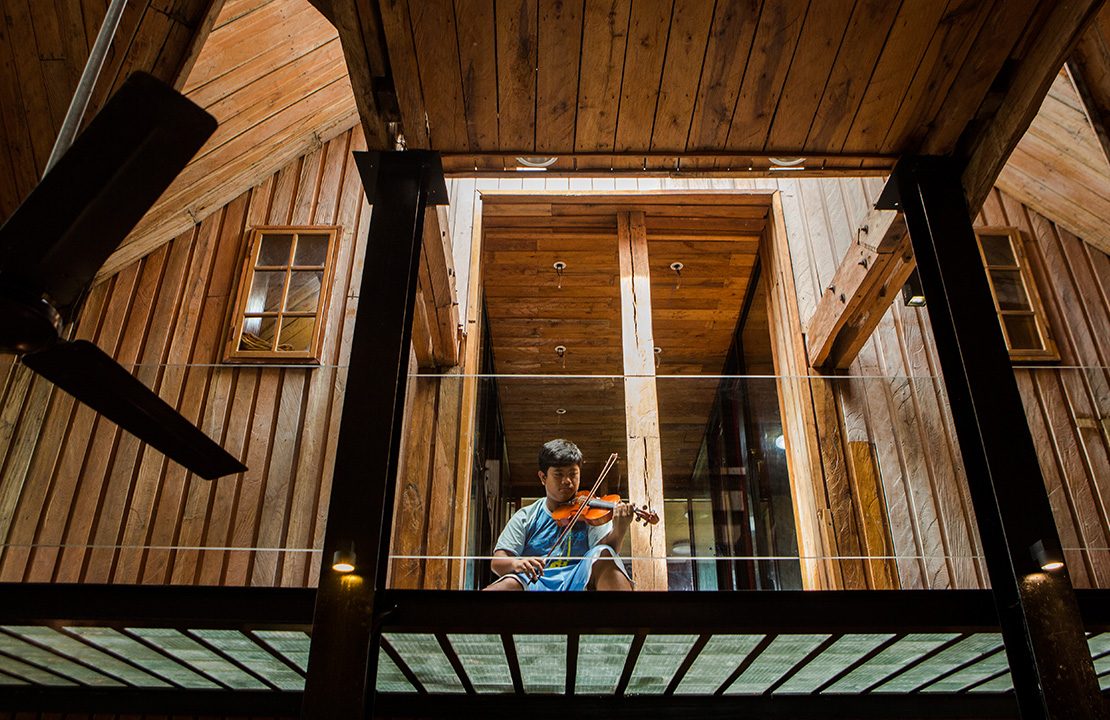There are children playing in the attic at nine in the morning. Depending on which point of view, it feels like a Sunday after mass, or the set of an eerie Tim Burton film when the wooden house resonates with strung violins and tiny voices practicing solfeggios.
The daily commotion brewing in faraway Manila feels almost non-existent here—or at least, inconsequential. Gate receptionist Virgie Soterio leads the way, showing us framed pictures of this old Zambales territory before it was called the now-famous Casa San Miguel.
“I know this house from way back,” she says, referring to a picture. “This is where we used to play [as kids]. It burned down during the 1980s.”
Built by Ramon Corpus in 1924, the old house was abandoned after the war broke out, save for a few summers when it housed a new generation of Bolipata children prancing and playing on its grounds, the same kids who grew up to become established artists in their own right. One of them is highly acclaimed concert violinist Alfonso “Coke” Bolipata who now presides over this house-turned-school, enlisting children to pick their instrument for the first time and learn how to play.

The first batch in 1996 was just—“nakakabingi nga eh” Bolipata says with a laugh. “I used to stand upstairs, close my eyes, and say, ‘Oh my god.’” Of course, when Casa San Miguel opened its musical gates to the all-too-reluctant public, even much more pressing than the students’ lack of training was the general community’s lack of support for what the establishment had stood for. “The biggest [question] for us the first year was ‘Why arts?’ People were like, ‘It’s post-Pinatubo. We need jobs.’”
That was in the early ’90s, the concluding years of a volcano eruption when Zambales went from third class province to ghost town. The base had closed, and while the people needed a source of livelihood, a way to make money, this relatively alien establishment was urging them to make some music.
Playing for ambassadors, diplomatic corps, and the rest of the elite majority only added to the intimidation. It took seven years and several attempts to court the locals before Casa San Miguel finally found its steady following. “With free concerts, we really pulled them in. We forced them to come.”
“The biggest [question] for us the first year was ‘Why arts?’ People were like, ‘It’s post-Pinatubo. We need jobs.’”
Over the course of two decades, with different shows and publications recording the Casa’s rise, the house became known for what it was initially chided for: a foundation where the arts, in its purest ardor, take center stage. In addition to the school, the old house has made room for bed and breakfast accommodations, a backstage café, a pasilyo where Plet Bolipata-Borlongan’s mosaic sculptures stand like welcoming figures from a Lewis Carrol novel, and mentorship-residency programs that have housed the likes of Elmer Borlongan, Manny Garibay, Leeroy New, and the late Don Salubayba.
“I don’t know how to explain it, but there’s something about the place that pulls you in. You wake up, eat, and create art,” says visual artist Carlo Gabuco who’s been Casa San Miguel’s resident artist for more than a decade now. He wasn’t working on any artwork when he started, but has since exhibited in Malaysia, Singapore, and the Finale Art File. Thank the many muses, maybe, that seem to have been serenaded by all the violinists’ weeping strings.

As the visual artists’ works fill Casa’s spaces like testaments of the creations that this haven has bred, the younger breeds of Zambaleños take mentorship from the maestros. Regular Sunday music lessons take place as well as summer camps where even Manila’s young enthusiasts come hungry for their share of Casa’s culture. Bolipata personally conducts the screenings and those who pass the talent test can avail of the scholarship. Those who undergo regular enrollment can borrow instruments from Casa. A far cry from the clumsy playing in the early ’90s, these student performances have now become a recognized act.
“They are in competitions, and we are now known in the conservatory circuits,” says Bolipata. A number of them are even bent on launching musical careers.
Knowing what goes on inside the house explains why many journalists, wide-eyed idealists, and Instagramming sightseers have been quick to dub it as an artist’s refuge. It has that air, anyway, of a utopia belonging to the pages of magic realism, which the media has, of course, stoked further, romanticizing the scenario of artists teaching the children of farmers and fishermen—gifted kids who would one day go to conservatories, follow a musical trajectory, and hopefully, end up becoming like Coke Bolipata.
Originally, though, this wasn’t Bolipata’s vision. “In the Philippines, there really are no jobs that are decent for musicians, unless you play in a hotel lobby or play in weddings,” says Bolipata wryly, noting that what they provide here at Casa San Miguel is a means of enrichment rather than a fixed necessity. Gabuco adds, “Most of my students come from the [local] community; financial problems are a common struggle.”

While Casa San Miguel seems at first acquaintance like a Disneyland sans the commercialized gags, the foundation may well be undergoing its second turning point, slowly shedding off the “art for art’s sake (alone)” anthem it has been known to represent all these years.
“The challenge [for us] is how not to really push a career in the arts because it’s not really that lucrative,” Bolipata clarifies. While the mentorship-residency programs continue, they’re simultaneously forging a way for the arts to be not just a blind aspiration but a starting point. “Now we’re linking with the Philippine High School for the Arts (PHSA) so that we can provide grades 11 and 12 and somehow create jobs for vocations in the arts. Instead of being a fine artist, you can become a draftsman for architecture firms.”
What distinguishes Casa San Miguel, of course, from every other educational institution is the simple fact that it’s a house, and that it gives its dwellers the necessary liberty to create their art. “[The students] live here with me,” says Bolipata, laughing. “They live upstairs. We live together. Even as a young artist, I always felt that whatever you do, you have to have your freedom. Never give up your freedom. . . Nobody would care about a little kid who plays the violin. The change is really between me and my student.”
Needless to say that years from now, Casa’s present students will be entering the workforce, but right now they have their music: their Vivaldis, their notes, and their art histories compelling them to always sing a different tune. Whichever act they find themselves in, we can be happily assured that the play goes on.
Writer: PRISTINE L DE LEON
PHOTOGRAPHY GERIC CRUZ




